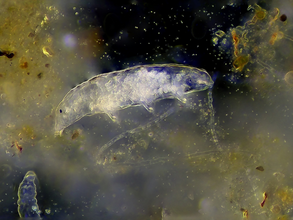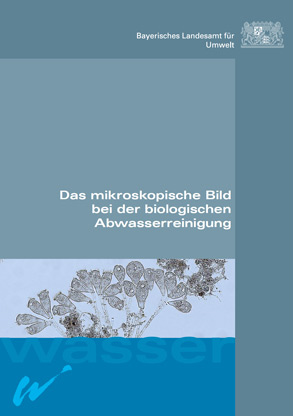This time I have a book recommendation for all readers interested in the topic "Microscopy in biological wastewater treatment".

Do you know what Tardigrada are? Probably not, but you may have heard or read its colloquial name. Tardigrada is the Latin name for waterbears. These are those strange, tiny creatures with eight stubby legs that are considered almost indestructible. Tardigrades can put themselves into a death-like state in stressful situations and thus survive the most extreme conditions such as temperatures close to absolute zero, high radioactive radiation and even the vacuum of free space. Tardigrada will therefore still exist when homo sapiens has long ceased to exist.
The blue book: Activated sludge seen through the microscope
Have you ever seen one of these alien-like creatures yourself? Most of you probably have not. But if you happen to operate a sewage treatment plant where the sludge age is not too short and you are equipped with a microscope, the chances of spotting one of these "water bears" are pretty good.

A look through a microscope into a biological sludge sample is always a fascinating insight into a seemingly alien microcosm. A variety of tiny microorganisms rush through the picture, some looking like little beetles scurrying along the edges of the sludge flocs, while others move more slowly constantly modifying their shape like shapeshifters, and still others sit on stalks and use rotating impellers to feed tiny particles into the transparent body.
But how are these strange creatures called? What does it mean when I spot a large number of them or maybe even when once there is no activity at all? You could ask a competent specialist, if you know one, or you can consult the related literature.
If you have been engaged in the field of activated sludge microscopy at municipal wastewater treatment plants for some time, you may have heard of the book
"Das mikroskopische Bild bei der biologischen Abwasserreinigung" (The Microscopic Picture in Biological Wastewater Treatment) - commonly known as “Das Blaue Buch” ("The Blue Book"), or you may be one of the lucky ones who even have your own copy at hand. The last edition dates from 1999 and has been hopelessly sold out for a sufficiently long time. Unfortunately, only a German edition was published. Therefore, experts outside the German-speaking regions will probably not be familiar with it.
The microscopic picture in biological wastewater treatment
Some time ago, leading experts in activated sludge microscopy from Germany, Austria and Switzerland joined forces again to introduce microscopy to a new generation of wastewater treatment plant professionals. After all, in addition to the chemical-physical parameters used for self-monitoring, the microscopic picture provides important information about stability or disruptions of the biological process step of the wastewater treatment plant.
The DWA working group KA 6.1 "Microbiology in Wastewater Treatment" was responsible for editing the new edition - including experts who had already worked on the 1999 issue. As almost 25 years ago, the book is being published by the Bavarian State Office for the Environment (LfU).
The outcome, like is predecessor, is a comprehensive compendium for the analysis of the microscopic picture, updated with new findings, adapted to the state of the art, equipped with new illustrations and corresponding to the requirements of the present day.
Filamentous bacteria are covered in more detail - also with their own sections to help identify the microorganisms responsible for, or at least involved in, a number of operational problems. In addition, the biology of filamentous bacteria is discussed more precisely and possible and appropriate countermeasures are addressed.
Key identification charts, fact sheets and an Excel tool
Key identification charts for both indicator organisms and filamentous bacteria, together with clearly laid out fact sheets, facilitate their identification. In addition, a practical Excel tool was developed and provided as a free
download, which makes it easier to interpret and evaluate the microscopic picture. In this way, operational issues or their potential causes can be classified and measures can be taken earlier, ideally well in advance of the occurrence of significant problems.
Coloring techniques in biological wastewater treatment
Of course, the staining methods that are usually essential for identifying filament types should not be missing. You have certainly heard of gram staining? But do you also know the Neisser staining method, the crystal violet staining or the Sulphur test? The “blue book” (“Blaue Buch”) gives practical instructions on how to carry out these staining methods and which aspects have to be considered. Believe me, the staining of sludge samples makes the microscopic analysis of the sludge really exciting. However, I would recommend wearing gloves when doing this if you don't want to return home with red and blue stained fingers.
Modern molecular biological methods for the identification of microorganisms
Finally, modern molecular biological identification methods such as the FISH test are also included in the new edition. Even if occasionally some fish may feel comfortable in the secondary clarifier, this test does not help to identify any fish, but to identify bacteria based on their DNA.
Using so-called specific hybridization probes, specific bacteria can be made visible by fluorescence in situ hybridization (hence "FISH" test) - provided you have a fluorescence microscope. In this way, not only filamentous bacteria can be classified with a high degree of accuracy, but also other bacteria (e.g. nitrifiers) can be made visible. The number of both alive and as well as dead organisms and the metabolic activity can also be quantified using molecular biological methods.
Wastewater treatment processes and systematic sludge screening
In the first sections, the basics are outlined: an overview of different wastewater treatment processes and their biological principles. Here you will learn about conventional activated sludge processes with secondary clarifiers, as well as SBR processes or biofilm processes. Bacterial growth, sludge load and sludge age are explained illustratively.
A very essential part of any book on microscopic sludge analysis is, of course, the set-up and handling of the key working tool: how does a microscope work, what is phase contrast, what is an ocular and an objective lens, how do I adjust the field diaphragm and the condenser? How do I treat a microscope? How can I prepare sludge slides and what do I have to consider?
If you are familiar with all this, then you are ready for a systematic microscopic sludge analysis. The identification charts will help you to identify ciliates such as the sessile Bell Animalcule Vorticella convallaria or Aspidisca cicada (which scurry through the picture like little beetles). You will see flagellates like Peranema sp. or amoebae like Arcella sp.. You will be able to identify filamentous bacteria such as Microthrix parvicella, resembling spaghetti, as well as the branched Nocardia. With the help of their profiles, you will be able to assess the importance of the individual organisms for the operation of the plant.
I can only recommend that you secure a copy of the "blue book" and enjoy reading it.
By the way, our Tardigrada, the waterbear, is also described in the book. Its profile and a couple of nice pictures can be found on page 172.